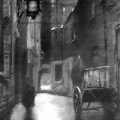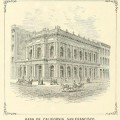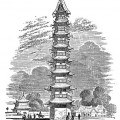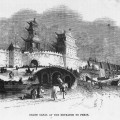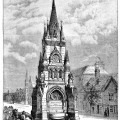I just know that some of the vintage images I find when working on Reusable Art have great stories to tell. While the individual drawing may not be something many people will talk about, the place depicted in the drawing is often the stuff of legend and wonder.
This drawing is from The Girl’s Own Paper, Vol. VIII: No. 356, October 23, 1886. It was a wonderful magazine but they unfortunately did not identify the many illustrators who filled their pages with images like this one.
This bridge in Lucerne Switzerland is still quite beautiful. But, according to the book in which it appeared, ‘the old bridge’ is more well known for its numerous paintings of the horrible subjects connected with the lives of SS. Leodegar and Maurice, the patrons of Lucerne. The paintings stem from the Counter-Reformation and depict old priests without heads and warriors worshiping them.
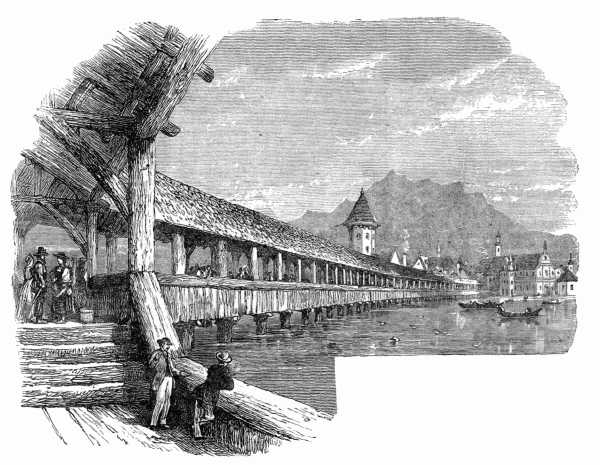
A more modern photo from Wikipedia which was taken by wikipedian Ikiwaner.

At first glance, it would seem that The Chapel Bridge is virtually unchanged between when the drawing was published in 1886 and when this photo was taken 130 years later in 2006. Sadly, that’s not the case.
But, before we get to that, let’s talk about why this bridge is so special to the people of Lucerne Switzerland.
The Kapellbrücke (“Chapel Bridge” in English) was originally built in 1333 to help protect Lucerne from invaders. There are historical ties to St. Mauritius and Leger of Autun (also referred to as SS. Leodigar, Lutgar, Ledodgar and Leger), who are the patrons of Lucerne. The court church of St. Legar is another Swiss landmark which is located only several blocks from Kapellbrücke. But, the bridge is named after nearby St. Peter’s Chapel.
The Kapellbrücke is a 670 feet long covered wooden footbridge. It spans the Reuss River and is the oldest wooden bridge in Europe and the world’s oldest surviving truss bridge.
The tower in the middle of the bridge, Wasserturm (“water tower” in English) has been used as a prison, torture chamber, watchtower and treasury. It was original built around 1300 and is now used as the guild hall of the artillery association and a gift shop.
The historical value of the Chapel Bridge and the Water Tower would be enough to make them worthy of a visit. But, it is the paintings housed on the bridge that are a major part of what has turned the bridge into a national treasure.
In between many of the trusses, there were 158 paintings that were created during the Counter-Reformation around 1545. City leaders wanted to show their loyalty to the Catholic church and commissioned the panels. One could say that they were early propaganda pieces. The depictions of St. Leodegar and Swiss history were meant to call the citizens of Lucerne to recall that a pious way of life and service would lead to happiness as well as a strong city. The panels began on the left bank of the Reuss, near the Jesuit church. The first panel depicted the giants of Reiden and ended with the presentation of the Jesuit College, now the Knight’s Palace.
Like many religious paintings of that era, the paintings on The Chapel Bridge depicted some of the horrors of the reformation and included a painting of the blinding of St. Leodegar.
Sadly, in a catastrophic fire in 1993, much of the bridge and the remaining 147 panels were destroyed. 47 of the panels were recovered but only 30 could be restored. The bridge and 30 remaining panels were quickly rebuilt and in 9 months the bridge was re-opened. Perhaps even more tragic is that there appears to be no plans to recreate the destroyed panels. I did see on the German version of Wikipedia that there is an on-going dispute over whether or not to display only the unburnt original panels or to create copies of the destroyed ones. (Not that it matters much what I say, but I do hope they commission copies to be made. Seems so much better than what they appear to be doing now – displaying nothing or black, charred panels where the original panels hung.)
I found only two photographs of the panels on the two versions of Wikipedia that I looked at.
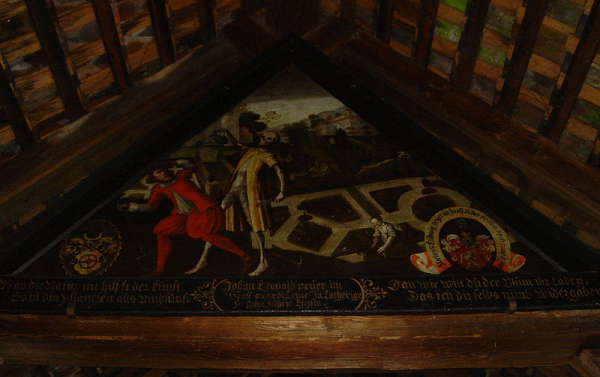
This panel is one of several depicting the “Dance of Death”, a concept that no matter what our station in life, death ultimately unites us all.
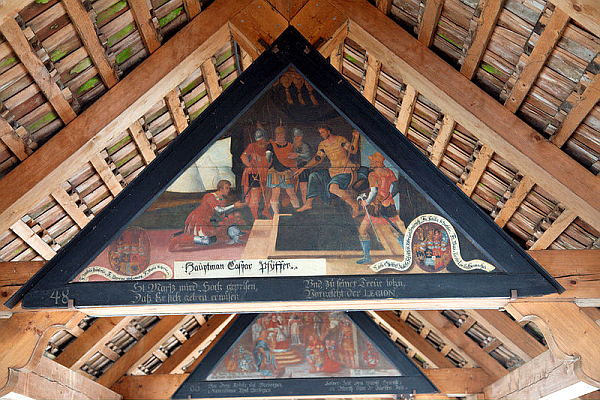 The photographer didn’t provide details on what this pair of panels depicts but it shows how the panels are displayed on the bridge.
The photographer didn’t provide details on what this pair of panels depicts but it shows how the panels are displayed on the bridge.
The Chapel Bridge is one of Switzerland’s most famous landmarks and one of it’s most visited historic sites. The official Lucerne visitor’s page refers to the bridge as “The Town’s Landmark.” It is open daily with widely varying hours. According to their Facebook page, the bridge may open as early as 6am on Fridays and remain open as late as 2 am on Tuesdays, Thursdays and Saturdays. Admission is free.
This image is copyright free and in the public domain anywhere that extends copyrights 70 years after death or at least 120 years after publication when the original illustrator is unknown.
